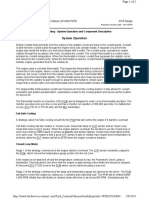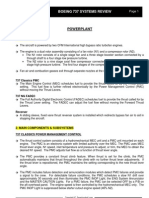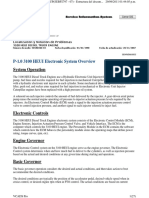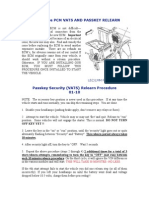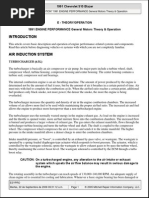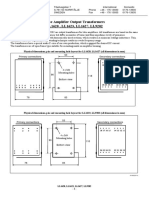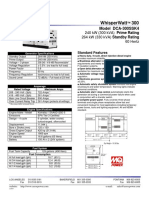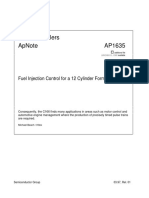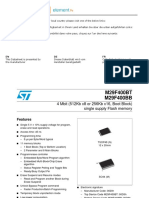Cat Eng-Er Serv PDF
Cat Eng-Er Serv PDF
Uploaded by
Giapy Phuc TranCopyright:
Available Formats
Cat Eng-Er Serv PDF
Cat Eng-Er Serv PDF
Uploaded by
Giapy Phuc TranOriginal Title
Copyright
Available Formats
Share this document
Did you find this document useful?
Is this content inappropriate?
Copyright:
Available Formats
Cat Eng-Er Serv PDF
Cat Eng-Er Serv PDF
Uploaded by
Giapy Phuc TranCopyright:
Available Formats
MVP-ER SERVICE MANUAL
Caterpillar 3126 HEUI Engines
The Caterpillar 3126 HEUI Engine introduces a new era of the diesel engine in the bus industry using the medium duty diesel engine. The basic engine takes advantage of the 3116's best features and years of experience and combines this with an electronically controlled fuel system, larger displacement, and other new features to produce the 3126. The fuel delivery system is controlled entirely by the Electronic Control Module, hereafter called the ECM. The actual delivery of the fuel into the combustion chambers is accomplished by the Hydraulic Electronic Unit Injector system (HEUI), which will be discussed later. The ECM will identify short/open sensors or operating conditions out of the normal range. It will alert the driver/mechanic through the use of failure codes that are displayed on the dash. At this point be advised that all subjects related to the operation and maintenance of the engine are covered in the 3100 HEUI manual provided with the chassis manual. Therefore no attempt is made herein to cover engine repairs. Service and operating instructions found in the Caterpillar manuals should be followed. When in need of information concerning the engine, contact your local Caterpillar dealer or distributor who is fully qualified and capable of handling all engine warranty and service repairs. Those responsible for operating and maintaining the buses powPage 13-1
MVP-ER SERVICE MANUAL
ered by the 3126 engine are encouraged to read and study the Caterpillar Operation and Maintenance manual at the earliest opportunity. Certain operational characteristics should be discussed with the bus operators to familiarize them on how the ECM controls various functions. Electronic Control Module The ECM controls its various functions through signals from the following sensors: Injection Actuation Pressure Turbo Boost Pressure Engine Speed Engine Timing Coolant Temperature Air Intake Temperature Throttle Position Vehicle Speed The ECM provides total electronic control of the start and duration of fuel injection. Data furnished by the sensors enable the ECM to control the fuel injected into each cylinder, which optimizes performance related to Normal and Cold weather starting, warm up, emissions, noise, fuel economy, and driveability. Top Engine Limit The ECM controls the top rpm of the engine, which is 2640 set at the factory, by limiting the fuel to the injectors. The engine does not have a mechanical governor. Start-Up and Emission Control White smoke is reduced by controlling injection timing and delivery during cold operation and acceleration. The ECM uses various sensor inputs to calculate timing and delivery that will not produce smoke. Vehicle Speed Limit Maximum road speed is predetermined by the owner/operator at time of writing the specifications for the bus and is programmed
Page 13-2
MVP-ER SERVICE MANUAL
into the ECM by the factory. When the programmed speed limit is reached the fuel to the injectors is limited, and will remain limited until the bus slows to a speed below the limited speed. Provisions have been made in the 3126 HEUI furnished by Thomas to allow for the fuel to be gradually reduced as maximum speed is approached, or about 2.5 mph before. This process, called Soft Vehicle Speed Limiting, prevents a sudden reduction of fuel at the top limit. The soft vehicle speed limiting causes the engine to operate at a reduced rpm while maintaining the desired maximum road speed - a must if the best fuel economy is to be realized. Engine Fast Idle The engine is set to idle at 700 rpm by the factory; however, provisions can be made for a fast idle of 1000 rpm on buses operating in cold climates. This requires a dash mounted ON/OFF switch with an "Enabled Indicator Light" on the switch.
Note: All circuits powered by the ignition switch will remain HOT after the timer shuts OFF. To avoid draining the batteries the ignition switch must be turned OFF at that time.
Idle Shutdown Timer The idle shutdown timer is designed to shut the engine OFF after a predetermined period of idling. This can be between 3 minutes and 60 minutes, depending on the initial programming. The "Check Engine" light on the dash will begin to flash rapidly 90 seconds before the engine shuts down. The driver can override the timer by depressing the brake pedal, if necessary, by doing so while the light is flashing. This is only if idle shutdown timer has been programmed to be overridden.
Note: Excessive coolant Engine Water Temperature Monitoring System temperature will not shut down the engine. One of the features of the ECM system monitors the temperature of the coolant. At 2250F (1070C) the "Check Engine" lamp will come ON. If programmed, at that point the engine will gradually "derate" in horsepower to a minimum of 120 hp, and road speed will gradually reduce to 45 mph. This gives the operator ample time to get off the road and prevent damage to the engine. All drivers should be advised of this feature.
Page 13-3
MVP-ER SERVICE MANUAL
The ECM System Diagnostics The ECM provides a flash code in the dash mounted "Check Engine" lamp in the event of malfunction in or of some component of the electronic control system. When the ECM detects a problem the "Check Engine" light will come ON, or is activated. At that time a failure diagnostic code will be entered and stored in the ECM memory. The failure code can be retrieved by 1) using the Caterpillar Electronic Control Service tool, or 2) using the "Check Engine" light if the bus is equipped with cruise control. Check Engine Light Operation When the ignition switch is turned ON, the lamp will illuminate for 5 seconds, which is a check to insure the lamp is working. The ECM can be programmed to notify the driver of an active fault or condition by blinking the lamp every 5 seconds after start-up. The "Check Engine" lamp is also used to warn, by flashing rapidly, that the "Idle Shutdown Timer" will shut the engine down in 90 seconds. The driver can override the timer by depressing the brake pedal, if necessary, by doing so while the light is flashing. This is only if idle shutdown timer has been programmed to be overridden. Retrieval of a Failure Code If the bus is equipped with Cruise Control the failure code can be determined by the procedure outlined below. If not so equipped, it will be necessary to use an Electronic Control Service tool that is available from your Caterpillar dealer or from certain other major tool suppliers. Use of the service tool will enable the mechanic to retrieve codes stored in the ECM memory system for periods longer than a day. Using the Cruise Control to Determine a Failure Code 1. 2. 3. Start the engine. Turn the Cruise Control switch to the OFF position. Move the SET/RESUME switch to either position and hold that position until the "Check Engine" lamp begins to
Page 13-4
MVP-ER SERVICE MANUAL
flash. The lamp will then flash to indicate a 2 digit code. Release the Cruise Control switch at this point. Count the first sequence of flashes to determine the first digit of the failure code. After a 2 second pause the second digit of the failure code will be flashed by the engine lamp. If additional faults have occurred, the applicable failure code(s) will then be flashed after a short pause. Flash code 55 signals "No Detected Faults" have occurred since the ignition switch was turned ON. This subject is covered more in detail on pages 50 and 51 in the 3100 HEUI Operation and Maintenance Manual. For various failure codes see the chart on page 13-11 for Diagnostic Flash Codes/Engine Performance Relationship. Initial Start-Up When coolant temperature is below 640F (180C) the ECM causes the engine to operate in a COLD MODE. During the COLD MODE operation the engine will operate at the predetermined FAST IDLE, 1000 rpm, horsepower is limited, and under certain conditions the AIR INLET Heater may operate. The engine should not be operated under full load until coolant temperature reaches 1600F (710C), which will reduce the possibility of sticking valves due to a build-up of unburned fuel on the valve stems. Inlet Air Heater and Lamp The Inlet Air system incorporates an Inlet Air Heater in the intake manifold and a "MAN HTR" Lamp on the dash, connected in parallel. When the heater is ON, the dash lamp is ON at the same time. The Inlet Air Heater is used to improve startability in cold weather and reduce white smoke. The ECM controls the heater and lamp through a relay mounted beside the intake manifold. Heater operation is determined during three stages of engine operation: Power-up/Preheat, Cranking, and Engine Started cycle.
Page 13-5
MVP-ER SERVICE MANUAL
The ECM is "powered-up" when the ignition switch is turned ON. The heater lamp should glow for 2 seconds or so, regardless of coolant temperature. If the combination of coolant temperature and inlet air temperature is less than 770F (250C) the ECM will turn the Inlet Air Heater and lamp ON for 30 seconds as a preheat, and then go OFF. If the operator attempts to start the engine during the "preheat" cycle the ECM will take over control of the heater during the "cranking" cycle. During the "cranking" cycle the heater will come ON if the combined temperatures of the coolant and the Inlet Air is less than 770F (250C) and will stay ON while cranking. If the engine fails to start, the heater will resume the 30 second "preheat" cycle. After the engine has started the heater operation is still determined by the combined temperatures of the coolant and Inlet Air. The "engine started" cycle has two parts: a continuous mode, followed by an ON/OFF cycle. The "continuous mode" lasts for a maximum of 7 minutes. The "ON/OFF" mode causes the heater to cycle ON and OFF at 10 second intervals. The "ON/OFF" mode can last up to 13 minutes. Either of these modes can or will be interrupted when the combined temperatures of the coolant and inlet air reaches 950F (350C). A failure or malfunction in either the inlet air sensor or the coolant temperature sensor will show up as a flash code on the "Check Engine" lamp. Throttle/Fuel Control The Electronic Control Module (ECM) controls the fuel flow to the cylinders. Instead of a direct rod/cable from the accelerator pedal to the fuel pump, the ECM receives a Pulse Width Modulation (PWM) from a throttle position sensor which incorporates a potentiometer. The sensor is located on the back side of the accelerator pedal. The ECM supplies 8 volts as input voltage to the potentiometer, not 12 volts from the chassis system. The throttle position senPage 13-6
MVP-ER SERVICE MANUAL
sor runs at a fixed frequency and amplitude. The 8 volts remain the same, as does the frequency, throughout the full range of pedal movement: the only thing that changes is the number of pulses within an extremely short period of time. The internal circuitry in the sensor causes a variation in the pulse width in the frequency, depending on the position of the accelerator pedal. The output signal from the sensor to the ECM is referred to as the Duty Cycle or Pulse Width Modulation, and is expressed as a percentage between 3 and 100%. At Low Idle the sensor will produce a duty cycle of 10-22%. At Full Throttle it will be 75-90%. This sensor-produced duty cycle is translated in the ECM which determines the timing and amount of fuel delivered to the cylinders. Throttle Position Sensor Test Procedure To test the TPS for being functional a meter that measures frequency and duty cycle is required, such as the FLUKE model 87. This particular meter is also a volt/ohm meter. DO NOT attempt to measure resistance of the TPS. To do so can cause catastrophic damage to the sensor.
Caution:
1. 2.
3. 4. 5. 6.
Ignition switch must be OFF. Disconnect the harness connector going to the throttle sensor, not any other connector. (This connector is located behind the left side windshield wiper motor access door.) Install a "breakout" T harness between the sensor and the chassis harness. Turn Ignition switch ON. Set the meter to % Duty Cycle position. Measure the duty cycle across Ground (pin B) and Signal (pin C). Closed throttle reading should be 10-22%. Full throttle should be 75-90%. If the percentage figures fall within these ranges, the sensor is good.
The same test can be made using the Caterpillar Electronic Analyzer and Programmer toll, their model #8T9697 and tool #8C9801 PWM Signal Adapter.
Page 13-7
MVP-ER SERVICE MANUAL
To make up a "breakout" T harness: 1. Join three 12" 10 AWG wires in the center of each with a 6" 20 AWG wire, making sure of 100% bond. 2. Place male Deutch connector #DT 04-3P-E004 on one end of the three 12" wires. 3. Place a female Deutch connector on the opposite end and on the 6" lead. 4. Using Caterpillar crimping tool, #1U5804, crimp the terminals onto each wire. See Figure 1.
Figure
There may be times when it is more expedient to install a new sensor or a new ECM in a process of elimination, which means it would be wise to have one of each in stock. Troubleshooting the Throttle Position Sensor System Considerable training is required of the service technicians, and investment must be made in some new sophisticated test equipment, as well as, having on hand the appropriate service and troubleshooting manuals from Caterpillar. The most critical manual is Caterpillar Electronic Troubleshooting #7AS1-UP, available from your area Caterpillar dealer. This manual goes through a step-by-step sequence in checking any given fault code that appears on the dash light. Other Items Related to Operating the 3126 HEUI Engine As mentioned earlier, all who are involved in operating and servicing this engine are encouraged to study the 3100 HEUI
Page 13-8
MVP-ER SERVICE MANUAL
Operation and Maintenance Manual furnished with the bus. Most comments made herein are excerpts from that manual and are intended only to provide a broad overview of what the ECM does and how the 3126 differs from older engines, as far as the fuel system is concerned. 1. 2. 3. Operating units with winterfront/shutters - refer to the section related to the cooling system. Fuel, lubricating oil, and coolant requirements are covered in the Caterpillar manual. Jump starting - no special precautions need to be taken to protect the electronic system, other than what you would normally do in any jump starting operation.
Welding on the Chassis Before welding on this bus equipped with an electronically controlled engine, the following precautions should be observed: 1. 2. 3. Disconnect all cables connected to the batteries. Disconnect both electrical connectors at the ECM. Do NOT use the ECM or engine ground stud for grounding the welder.
Customer Specifications The customer determines certain parameters when writing the specifications for this bus. (See page 13-12.) At that time he or she was given the option of programming a password into the ECM. Unless the correct password is entered, it is impossible to change the maximum engine RPM originally programmed. The same thing applies to the Vehicle Maximum Speed limit and any other parameters that the customer specified. Certain features of the ECM system are controlled only by Caterpillar, consequently Caterpillar has its own password. However, customer passwords are not required for the engine to operate. The purpose is to prevent unauthorized alterations of the system as originally set up. If the customer password(s) is (are) forgotten or misplaced, arrangements have to be made with the Caterpillar dealer to obtain the factory password if a change in one of the features is desired.
Page 13-9
MVP-ER SERVICE MANUAL
Tamper Resistance One of the features of the ECM is a programmed tamper resistance. This prevents the vehicle from exceeding its preset maximum road speed in the event the vehicle speed signal is lost. Example: Assume the rear axle ratio would allow the vehicle to run 72 mph at 2400 rpm; however, management wants a maximum of 60 mph. This is programmed into the ECM by the factory, which means the engine would be turning over only 1600 rpm. (These are only figures used for the purpose of explaining how the Vehicle Speed Limit works.) IF the speed signal is lost, the bus would run 72 mph without the tamper resistance feature. With this feature, however, it will run only 60 mph, and under greatly reduced power. Caterpillar Hydraulic Electronic Unit Injector System The Caterpillar Hydraulic Electronic Unit Injector (HEUI) system uses the ECM to control the injection of fuel, using high pressure engine oil to provide the "muscle" instead of a cam shaft. In a conventional mechanical fuel system fuel injection pressures increases proportionally with engine speed, whereas the HEUI is electronically controlled independent of engine speed. Both the start and end of injection are electronically controlled. Plunger movement timing is NOT limited to the speed or shape of a camshaft. The next several pages describe how the HEUI system operates.
Page 13-10
MVP-ER SERVICE MANUAL
DIAGNOSTIC FLASH CODE/ENGINE PERFORMANCE RELATIONSHIP - 3100 HEUI DIESEL ENGINE
DIAGNOSTIC FLASH CODE EFFECT ON ENGINE PERFORMANCE
Engine Misfire
01 - Idle Shutdown Override 15 - Injection Actuation Pressure Sensor Fault 17 - Excessive Injection Actuation Pressure Fault (1) 18 - Injection Actuation Pressure Control Valve Driver Fault 19 - Injection Actuation Pressure System Fault 21 - Sensor Supply Voltage Fault (1, 2) 25 - Boost Pressure Sensor Fault (1) 27 - Coolant Temperature Sensor Fault (1, 2) 28 - Check Throttle Sensor Adjustment 31 - Loss of Vehicle Speed Signal 32 - Throttle Position Sensor Fault 34 - Engine RPM Signal Fault 35 - Engine Overspeed Warning 36 - Vehicle Speed Signal Fault 38 - Air Inlet Temperature Sensor Fault (1, 2) 41 - Vehicle Overspeed Warning 47 - Idle Shutdown Occurrence 49 - Inlet Air Heater Driver Fault (1) 51 - Intermittent Battery Power to ECM 55 - No Detected Faults 56 - Check Customer/System Parameters 59 - Incorrect Engine Software 61 - High/Very High Coolant Temperature Warning 71 - Cylinder 1 Fault 72 - Cylinder 2 Fault 73 - Cylinder 3 Fault 74 - Cylinder 4 Fault 75 - Cylinder 5 Fault 76 - Cylinder 6 Fault 42 - Check Sensor Calibrations x x x
SUGGESTED DRIVER ACTION
Shutdown Vehicle Service ASAP
* * * * x x
Low Power
* * x * * x
Engine Speed Reduced
* * x *
Engine Shutdown
Schedule Service
* * * *
x * * * x * * * * * x x * * * * * * * * * * * * x x * x x
* * x
x * * * *
* x * * * * * * * * * *
NOTE: An X indicates that the effect on engine performance WILL occur if the code is active. An asterisk (*) mark indicates that effect on engine performance MAY occur if the code is active. 1. These Diagnostic Flash Codes may affect the system only under specific environmental conditions such as cold weather start-up of engine or cold weather operation at high altitude. 2. These Diagnostic Flash Codes reduce the effectiveness of the engine monitoring feature when active. Shutdown Vehicle: Drive the vehicle cautiously off the road and get immediate service. Severe engine damage may result. Service ASAP: Driver should go to the nearest qualified service location. Schedule: Driver should have problem investigated when convenient.
Page 13-11
MVP-ER SERVICE MANUAL
MVP-ER SERVICE MANUAL
CAT 3126 CUSTOMER PARAMETER WORKSHEET
*To accompany each order or parameters will be defaulted.
PARAMETER Vehicle Speed Limiting If customer doesn't specify, speed will be set at 65 mph 105 km. Actual maximum speed depends on axle ratio. Seventy mph maximum speed allowed on school bus models. Vehicle Speed Limiting Protection Idle Shutdown Timer
PARAMETER SETTING ________________ MPH
or
________________ KM Yes _______ No _______ ________________ Minutes 3 to 60 minutes Yes ______ No _______ Choose One: _________ Hours or _________ Mileage/KM ____________________ Up to 8 digits: letters or numbers
Diagnostic Flash Code/Engine Performance Relationship Chart Inside
Idle Shutdown Timer Override Maintenance Data PM Schedule
Customer Password
Customer Name _______________________________ Address ______________________________________ City, State ____________________________________
Selling Distributor _____________________________ Distributor Order Number ______________________
Page 13-12
MVP-ER SERVICE MANUAL
Caterpillar 3126 Product News Higher Injection Pressures An intensifier piston in the HEUI injector multiplies hydraulic force on the plunger. By varying hydraulic input pressure, injection pressure can be controlled in a range from 5,000 to 21,000 psi. These high pressures are available at idle as well as high engine speeds. The higher injection pressures improve fuel economy, performance, and emission capabilities.
HEUI System Components 1. Electronic Control Module (ECM): The ECM is a microprocessor based system which monitors various inputs and sensors from the vehicle and engine as it controls the operation of the entire fuel system. It contains information defining optimum fuel system operational parameters. The ECM also has many more external operational inputs than a mechanical governor such as engine speed, timing, rail pressure, boost pressure, etc. It can determine optimum fuel rate and injection timing for any condition. It sends a precisely controlled signal to energize the injector solenoid. Electronic conPage 13-13
MVP-ER SERVICE MANUAL
trols such as these are invaluable in meeting new standards of exhaust emissions and noise while maintaining excellent fuel economy. The ECM has the ability to store data on mileage, fuel consumed, and hours operated. 2. High Pressure Oil Supply Pump: The hydraulic supply pump is a seven-piston fixed displacement axial piston pump. It raises the system's oil pressure level from typical engine operating oil pressure of 40 psi to the actuation pressure required by the injectors of 870 to 3300 psi. During normal engine operation, pump output pressure is controlled by the Injector Actuation Pressure Control Valve (IAPCV) which dumps excess flow back to the return circuit. Pressures for specific engine conditions are determined by the ECM. Injector Actuation Pressure Control Valve: The IAPCV is an electrically operated dump valve which closely controls pump output pressure by dumping excess flow back to the oil sump. A variable signal from the ECM to the IAPCV determines pump output pressure. Pressure while cranking a cold engine (below 500F [100C]) is slightly higher because cold oil is thicker and components in the injector move slower. The higher pressure and advanced injection timing helps the injector to fire faster until the viscosity of the oil is reduced.
3.
4.
HEUI Injector: The injector uses the hydraulic energy of the pressurized oil to cause injection. The pressure of the incoming oil controls the speed of the intensifier piston and plunger movement, and therefore, the rate of injection. The amount of fuel injected is determined by the duration of
Page 13-14
MVP-ER SERVICE MANUAL
the pulse from the ECM and how long it keeps the solenoid energized. As long as the solenoid is energized and the poppet valve is off its seat, oil continues to push down the intensifier and plunger until the intensifier reaches the bottom of its bore. Since the HEUI injector is the heart of the system, let's look at its operation in detail.
Injector The HEUI injector is hydraulically actuated by high pressure engine oil supplied by the high pressure oil pump. It consists of four major components: 1. Solenoid: The solenoid is a very fast acting electromagnet which, when energized, pulls the poppet valve off its seat. Poppet Valve: The poppet valve is held on its seat by a spring. In this closed position, high pressure inlet oil is blocked and the intensifier cavity is opened to drain. When the solenoid is energized, the poppet is quickly lifted off its seat. The path to drain is closed and the inlet for high pressure oil is opened. Intensifier Piston and Plunger: When the poppet valve opens the inlet port, high pressure oil enters the injector and acts on the top of the intensifier piston. Pressure builds on the intensifier, pushing it and the plunger down. The intensifier is six times larger in surface area than the plunger, providing six times multiplicaPage 13-15
2.
3.
MVP-ER SERVICE MANUAL
tion of force. The downward movement of the plunger pressurizes the fuel in the plunger cavity, causing the nozzle to open. Thus 3,000 psi oil provides fuel injection pressures of 21,000 psi.
4.
Nozzle Assembly: The nozzle assembly is of conventional design with the exception of the fill check. This check ball seats and seals during the downward stroke of the plunger to prevent leakage of the high pressure fuel. During the return stroke, it unseats allowing the plunger cavity to fill. The nozzle valve is an inwardly opening type which lifts off its seat when pressure overcomes the spring force. Fuel is then atomized at high pressure through the nozzle tip.
Stages of Injection There are three stages of injection with HEUI: 1. Fill Cycle: During pre-injection all internal components have returned to their spring loaded (non-actuated) positions.
Page 13-16
MVP-ER SERVICE MANUAL
The solenoid is not energized and the poppet valve is blocking high pressure oil from entering the injector. The plunger and intensifier are at the top of their bore and the plunger cavity is full of fuel. Fuel pressure in the plunger cavity is the same as fuel rail pressure, about 30 psi, depending on conditions.
2.
Injection: When the ECM determines the injector should fire, the following sequence of events occurs: ECM sends signal pulse to injector solenoid, Solenoid is fully energized almost instantly creating a strong magnetic pull on the armature. The armature is connected to the poppet valve. The injection process begins when: Magnetic pull of solenoid overcome spring tension holding the poppet closed, Poppet is quickly raised off its seat. When poppet valve opens: Upper poppet land closes off path to drain,
Page 13-17
MVP-ER SERVICE MANUAL
Lower land opens poppet chamber to incoming high pressure oil, High pressure oil flows around poppet to the top of intensifier piston.
Pressure on the top of the intensifier forces it down along with the plunger. The downward movement of the plunger pressurizes the fuel in the plunger cavity and nozzle. When the fuel pressure reaches Valve Opening Pressure (VOP) of about 4,500 psi, the nozzle valve lifts off its seat and injection begins. As long as the solenoid is energized, the poppet remains open and pressurized oil continues to flow in, pushing down the intensifier and plunger. Injection pressure ranges from 5,000-21,000 psi depending on engine requirements. Injection continues until the solenoid is deenergized, allowing the poppet spring to close the poppet and shut off the high pressure oil.
Page 13-18
MVP-ER SERVICE MANUAL
3. End of Injection: a. Drain Cycle The end of the injection cycle begins when the ECM terminates the electric pulse to the solenoid. The following events occur: The magnetic field of the solenoid collapses and is no longer able to overcome poppet spring tension to hold the poppet off its seat. The poppet closes, shutting off high pressure oil from entering the injector. When the poppet is seated, the upper land of the poppet opens the poppet cavity to drain. Pressurized oil in the intensifier chamber and poppet chamber flows upward around the poppet seat, through the vent holes in the poppet sleeve and out the adapter drain hole. The pressure of the fuel in the plunger cavity exerts an upward force on the plunger and intensifier. As the pressure of the pressurized oil above the intensifier drops, so does the downward force on the intensifier.
Page 13-19
MVP-ER SERVICE MANUAL
The upward force from the pressurized fuel almost instantly becomes greater than the downward force on the intensifier so the downward motion of the intensifier and plunger stops. When the plunger stops, fuel flow also stops. With the check still open, the remaining pressure on the fuel pushes a tiny amount of additional fuel out the orifice holes. This causes a large pressure drop which lowers nozzle pressure below Valve Closing Pressure (VCP) of 3,200 psi. Spring tension on the check then reseats the check and injection stops.
b.
Fill Cycle When the check closes, injection stops and the fill cycle starts as follows: The poppet and intensifier cavities are open to atmospheric pressure through the poppet valve and adapter drain hole. Pressure drops very rapidly in the intensifier and plunger cavities to near zero.
Page 13-20
MVP-ER SERVICE MANUAL
The plunger return spring pushes upward on the plunger and intensifier forcing oil around the poppet, through the holes in the poppet sleeve and out the adapter drain hole. As the plunger rises, pressure in the plunger cavity also drops to near zero. The fuel rail pressure unseats the plunger fill check, allowing the plunger cavity to fill with fuel. The fill cycle ends when the intensifier is pushed to the top of its bore. The plunger cavity is full and the fill check returns to its seat. Pressure in the intensifier and poppet chambers is zero. The injection cycle is complete and is ready to begin again.
Engine Replacement No attempt is made herein to cover subjects related to maintenance and repairs to the Caterpillar Engine. These services are covered in the engine manual furnished by the Caterpillar. These instructions should be followed at all times. Your local Caterpillar facility is dedicated and capable of performing warranty repairs and other engine maintenance repairs. Contact your local Caterpillar distributor on any questions or problems related to engine performance. Some basic suggestions should be considered when preparing to remove the engine. 1. Place the bus on a clean, level, smooth floor to facilitate easy movement of the floor crane (fork lift) and transmission jack. Leave adequate room behind the bus to allow for safe removal of the engine package. Set parking brakes, chock rear wheels. Disconnect battery cables. If the bus is to be idle for an extended period, remove the batteries and place them on a trickle charge, or use them elsewhere. Close the heater shut-off valves to prevent draining the entire system. Drain coolant in a clean receptacle and store in a clean container.
Page 13-21
2. 3.
4. 5.
MVP-ER SERVICE MANUAL
6. 7. Drain engine oil, transmission fluid, hydraulic fluids and dispose according to local ordinances. If a new or rebuilt engine is installed, or coolant is contaminated, remove the radiator and send it out for cleaning and flow testing. Important: Install identification tags on each electrical circuit, harness connector, air lines, and hoses as they are removed. This will save much time and confusion later as the replacement engine is installed. The electronically controlled engines have several harnesses and hoses that are a part of the engine package, and can be removed with the engine assembly. Removing them and replacing them with the engine in place can be very time consuming. Study these items before beginning the engine removal process.
8.
The following suggestions are intended to remove the engine and transmission as a package, along with some of the hoses and harnesses. The limited space between the engine and frame rail on the right side makes access difficult to some of the connections. Some may elect to remove the transmission first, this is a local decision. Engine Removal 1. 2. 3. 4. 5. 6. 7. 8. 9. 10.
Page 13-22
All steps mentioned above have been observed. Remove the engine compartment rear door, if a fork lift is to be used to pull the engine. Remove body rear bumper assembly. Remove chassis rear bumper, and chassis upper crossbar. Remove fan drive belt. See Cooling Section. Remove charge air cooler hoses and piping. Cover all openings. Remove intake air cleaner piping and hoses, as necessary. Cover opening. Disconnect all coolant hoses from engine. Remove hydraulic reservoir from chassis for better access to right side of engine. Disconnect main discharge air line from air compressor.
MVP-ER SERVICE MANUAL
11. 12. 13. 14. 15. 16. 17. 18. 19. 20. 21. 22. 23. Disconnect air line at D-2 governor. Disconnect pressure hose from hydraulic pump. Disconnect oil pressure hose from engine block at rear of power steering pump. Remove fuel filter assembly from it's mounting bracket, remove with engine package. Disconnect fuel return hose at rear of engine. Disconnect fan clutch air line at fan clutch solenoid, pull hose back over to radiator side. Remove battery positive cable from starter post. Remove battery ground cable and chassis ground cable from starter ground post. Disconnect chassis harness from ECU module. Disconnect intake air temperature sensor harness at connector. Disconnect coolant temperature sensor(s) at front of engine. Disconnect alternator field and tachometer wires at alternator. All above circuits are included into a 1/2" convoluted harness. Cut tie wraps and pull this harness back to rear and right side of chassis. Remove battery cable from alternator, pull cable off to right side of chassis. Remove heater hoses at engine cut-off valves. Disconnect exhaust pipe from turbocharger, hang off out of way. Remove transmission dipstick tube from transmission. Disconnect transmission oil temperature sensor wire. Disconnect chassis harness from transmission at the connector on right side of transmission. Disconnect from sensor wire. Disconnect transmission oil cooler hoses. Remove propeller shaft from transmission. Secure shaft out of way. Remove engine mount bolts, front and rear. Connect lifting mechanism to front of engine. Place transmission jack beneath transmission. Lift engine and transmission slightly. Remove front and rear engine support crossmembers. Using an assistant to guide the rear of the assembly, carefully pull the package from the chassis.
Page 13-23
24. 25. 26. 27. 28. 29.
30. 31. 32. 33.
Caution: Make sure
not to damage transmission oil pan with transmission jack, and that the unit cannot slip on jack.
34. 35. 36.
MVP-ER SERVICE MANUAL
37. If a new or replacement engine is to be installed, transfer When all accessories, hoses, and harnesses to the new engine. pulling the package from the Make sure all are installed in exactly the same position chassis, make sure that all and location as removed from old engine. hoses, harnesses, and cables are disconnected If this engine has over 250,000 miles, consider replacing or and secured from possible rebuilding the alternator, starter, power steering pump, and air damage. compressor at this time, if they have not been replaced before.
Caution:
If the radiator has not been cleaned, consider flushing it at this time. Engine Installation Assuming all accessories, hoses, harnesses, etc. have been installed on the replacement engine in the same position as removed form the old engine, prepare the package for installation into the chassis. Temporarily tie wrap all loose hoses or harnesses closely to the package to prevent entanglement as the engine is moved into place.
Caution: When moving the assembly into the chassis, be careful to prevent damage to hoses, harnesses, cables, etc.
1.
Note: It may be advantageous to loosen the crossmember mounting brackets on one side of the frame if difficulty is experienced in installing the crossmembers to their mounting brackets.
2.
With the engine front lift mechanism in place and the transmission jack securely in place, position the package to ensure a minimum of problems while moving the assembly into the chassis. With one or two assistants, carefully move the assembly in place. Install front and rear engine support crossmembers. After all crossmembers are in place, torque all bolts to the values shown below. All fasteners used on the Thomas chassis are SAE grade 8. Bolt Size
3/4-10 3/4-16 5/8-11 5/8-18 1/2-13 1/2-20
Torque Value
280 ft/lbs. 320 ft/lbs. 170 ft/lbs. 180 ft/lbs. 80 ft/lbs. 90 ft/lbs.
3.
Place engine mount isolators in place, lower engine in place, and install engine mount bolts. Torque front and rear bolts to 226 ft/lbs.
Page 13-24
MVP-ER SERVICE MANUAL
4. At this point the most critical area of the installation process lies in the proper routing, connecting, and securing all items to safeguard against chafing or interference with other objects. Reverse the procedures outlined in removing the package, and proceed with the installation process. Follow the instructions outlined in the cooling system section as to filling and bleeding the cooling system. Fan belt installation and adjustment is also covered in this section. See Caution in the margin. After all fluids, lubricants, etc. have been installed, remove the fuel solenoid wire from the fuel solenoid. Spin the engine over with the starter until pressure is registered on the oil pressure gauge. Reconnect the solenoid wire, start the engine and check for leaks, proper operation. Top off all fluid levels. Test drive unit for several miles for proper performance, leaks, etc.
5. 6.
Take extreme care to see that no loose bolts, nuts, washers, debris are inside any of the pipes, hoses used in the engine intake air system; otherwise severe damage can be caused to the turbocharger and inside the combustion chambers.
Caution:
7.
8.
Page 13-25
You might also like
- Edc System For Bs III - Bs IVDocument55 pagesEdc System For Bs III - Bs IVAparnesh Mukhopadhyay86% (174)
- 6.6l Duramax Engine DiagnosisDocument54 pages6.6l Duramax Engine DiagnosisGiapy Phuc Tran86% (14)
- Service 3126Document18 pagesService 3126jrrodrigueza293% (15)
- Manual Services 3126B PDFDocument14 pagesManual Services 3126B PDFdiony182100% (1)
- CAT - G3516H System Overview PDFDocument3 pagesCAT - G3516H System Overview PDFwagner_guimarães_1100% (1)
- Scavenge LimiterDocument13 pagesScavenge LimiterMario Andrew100% (1)
- Siemens MS43 SystemsDocument26 pagesSiemens MS43 SystemszefrenchNo ratings yet
- Service Manual dd15Document29 pagesService Manual dd15Eduardo Villatoro91% (11)
- 3412 Generator Set Engines Electronically Contr-1 PDFDocument50 pages3412 Generator Set Engines Electronically Contr-1 PDFFrezgi Birhanu100% (3)
- CAT 3500b Application GuideDocument9 pagesCAT 3500b Application GuideKhaled Kamel80% (5)
- 3grfse 1Document42 pages3grfse 1Zoli Borbely100% (3)
- 3126 HeuiDocument26 pages3126 HeuiBradley LodderNo ratings yet
- Caterpillar 3126 HEUI Engines: Mvp-Er Service ManualDocument6 pagesCaterpillar 3126 HEUI Engines: Mvp-Er Service ManualJesus Almanzar SantosNo ratings yet
- Caterpillar 3126 HEUI Engine: Mvp-Ef Service ManualDocument18 pagesCaterpillar 3126 HEUI Engine: Mvp-Ef Service ManualDarwin PerdomoNo ratings yet
- 3126 Truck Engine 7LZ00001-UP (SEBP2797 - 14) - Documentation..Document53 pages3126 Truck Engine 7LZ00001-UP (SEBP2797 - 14) - Documentation..4l3x4nd3rNo ratings yet
- 303-03 Engine Cooling 2.3L EcoBoost - Description and Operation - System OperationDocument3 pages303-03 Engine Cooling 2.3L EcoBoost - Description and Operation - System OperationCARLOS LIMADANo ratings yet
- ASE L2 Composite Vehicle 2007Document0 pagesASE L2 Composite Vehicle 2007Anil YarlagaddaNo ratings yet
- Gauges and IndicatorsDocument3 pagesGauges and Indicatorsbenjir shuvoNo ratings yet
- Start Stop System Automobiles: Submitted By: Garima Madan Eee 7 SEM ROLL NO. 0771504907Document52 pagesStart Stop System Automobiles: Submitted By: Garima Madan Eee 7 SEM ROLL NO. 0771504907Garima MadanNo ratings yet
- Section 1 - Operating InstructionsDocument19 pagesSection 1 - Operating InstructionsrapoleNo ratings yet
- Cis Information DiagnosisDocument17 pagesCis Information DiagnosisrezakecilNo ratings yet
- B737-Powerplant Systems SummaryDocument16 pagesB737-Powerplant Systems SummaryOB ChavasNo ratings yet
- 1.troubleshoot Engine Crank But Cant StartDocument3 pages1.troubleshoot Engine Crank But Cant StartsyahrilNo ratings yet
- Engine StartDocument7 pagesEngine StartThwin Zaw BoNo ratings yet
- Pruebas y AjustesDocument72 pagesPruebas y Ajustesdamian_pelonNo ratings yet
- InternshipDocument45 pagesInternshipPrakashRaiNo ratings yet
- 1986 Mercedes Benz Cis-E Fuel Injection System-1Document23 pages1986 Mercedes Benz Cis-E Fuel Injection System-1Jen Steel100% (9)
- TE Series Power Unit Controller Start InstructionsDocument13 pagesTE Series Power Unit Controller Start InstructionsFrances SalongaNo ratings yet
- Exhaust System Overview ISL9 CM2350Document34 pagesExhaust System Overview ISL9 CM2350jonNo ratings yet
- Sistema de Control de EmisionesDocument45 pagesSistema de Control de EmisionesDavid ParariNo ratings yet
- Senr6483-00 3412 PeecDocument59 pagesSenr6483-00 3412 PeecJeff Hill80% (5)
- Kia - Spectra - Wiring Diagram - 2003 - 2003Document6,450 pagesKia - Spectra - Wiring Diagram - 2003 - 2003Nisrina apriliaNo ratings yet
- CAT 3408E 3412E EngineDocument11 pagesCAT 3408E 3412E EngineNasser AyoubNo ratings yet
- Tier3 ElectricDocument10 pagesTier3 ElectricLuong Nguyen Danh100% (1)
- Description of The Dme 3.3 System Used On E32 V8'SDocument9 pagesDescription of The Dme 3.3 System Used On E32 V8'Srmp2012No ratings yet
- Powertrain Control SoftwareDocument6 pagesPowertrain Control SoftwareJosé Antonio100% (1)
- MAN 5LC90 SIMULATOR VLCC Part 2.Document34 pagesMAN 5LC90 SIMULATOR VLCC Part 2.r0x0rNo ratings yet
- Throttle Learning 2Document2 pagesThrottle Learning 2Indy RufSanNo ratings yet
- Initial Start Up Procedure g3516bDocument16 pagesInitial Start Up Procedure g3516bmuhammad arifNo ratings yet
- 3504a PDFDocument95 pages3504a PDFfernando100% (1)
- DisplayDocument2 pagesDisplaybilmon selviantoNo ratings yet
- Code 114Document6 pagesCode 114Enrrique LaraNo ratings yet
- OMM - Gauges and IndicatorsDocument3 pagesOMM - Gauges and Indicatorsjordan navarroNo ratings yet
- Heui CatDocument27 pagesHeui CatVago Si BeerNo ratings yet
- TE804Document38 pagesTE804byronsmart100% (2)
- 2012 Ram Diesel Supplement 4thDocument173 pages2012 Ram Diesel Supplement 4thlilfroger100% (1)
- Ecm Installation and RelearnDocument4 pagesEcm Installation and RelearnCarTech DynoNo ratings yet
- Chevrolet Blazer - Engine Performance Theory - OperationDocument30 pagesChevrolet Blazer - Engine Performance Theory - Operationprovajuv100% (1)
- Additional Information On The Low Pressure Fuel SystemDocument20 pagesAdditional Information On The Low Pressure Fuel Systemevan100% (1)
- Challenger7 Fly by Wire - V100Document21 pagesChallenger7 Fly by Wire - V100GustavoNo ratings yet
- 6295 2 15 PDFDocument6 pages6295 2 15 PDFTrent ScheuerNo ratings yet
- 2000 7.3L Diesel SupplementDocument39 pages2000 7.3L Diesel SupplementInventour100% (1)
- Side Instrument Bezel and ControlsDocument2 pagesSide Instrument Bezel and ControlsAngel RosasNo ratings yet
- Dse704 Manual PDFDocument15 pagesDse704 Manual PDFJulio Hinostroza AlarconNo ratings yet
- How to Build & Power Tune Distributor-type Ignition Systems: New 3rd Edition!From EverandHow to Build & Power Tune Distributor-type Ignition Systems: New 3rd Edition!No ratings yet
- Installation and Operation Instructions For Custom Mark III CP Series Oil Fired UnitFrom EverandInstallation and Operation Instructions For Custom Mark III CP Series Oil Fired UnitNo ratings yet
- Small Engines and Outdoor Power Equipment: A Care & Repair Guide for: Lawn Mowers, Snowblowers & Small Gas-Powered ImplementsFrom EverandSmall Engines and Outdoor Power Equipment: A Care & Repair Guide for: Lawn Mowers, Snowblowers & Small Gas-Powered ImplementsNo ratings yet
- Lundahl: Amorphous Core Moving Coil Input Transformer LL1931Document1 pageLundahl: Amorphous Core Moving Coil Input Transformer LL1931Giapy Phuc TranNo ratings yet
- CD Ignition System: 03229 (Rev. A)Document2 pagesCD Ignition System: 03229 (Rev. A)Giapy Phuc TranNo ratings yet
- Bts 2140Document1 pageBts 2140Giapy Phuc TranNo ratings yet
- 1620 3 7 9202Document4 pages1620 3 7 9202Giapy Phuc TranNo ratings yet
- Dca 300ssk4Document1 pageDca 300ssk4Giapy Phuc TranNo ratings yet
- Ap163502 Injection DieselDocument6 pagesAp163502 Injection DieselGiapy Phuc TranNo ratings yet
- Bts 7960Document28 pagesBts 7960Nairo FilhoNo ratings yet
- Infineon TLE4270 2 DS v01 08 enDocument17 pagesInfineon TLE4270 2 DS v01 08 enGiapy Phuc TranNo ratings yet
- Tle 2425Document24 pagesTle 2425Giapy Phuc TranNo ratings yet
- Am29F200B: 2 Megabit (256 K X 8-Bit/128 K X 16-Bit) CMOS 5.0 Volt-Only, Boot Sector Flash MemoryDocument39 pagesAm29F200B: 2 Megabit (256 K X 8-Bit/128 K X 16-Bit) CMOS 5.0 Volt-Only, Boot Sector Flash MemoryGiapy Phuc TranNo ratings yet
- M95640-W M95640-R M95640-DF: 64-Kbit Serial SPI Bus EEPROM With High-Speed ClockDocument53 pagesM95640-W M95640-R M95640-DF: 64-Kbit Serial SPI Bus EEPROM With High-Speed ClockGiapy Phuc TranNo ratings yet
- Monitor Amplifier: DescriptionDocument17 pagesMonitor Amplifier: DescriptionGiapy Phuc TranNo ratings yet
- Smart Four Channel Highside Power Switch: BTS711L1Document17 pagesSmart Four Channel Highside Power Switch: BTS711L1Giapy Phuc TranNo ratings yet
- M29F400BB70N6EDocument42 pagesM29F400BB70N6EGiapy Phuc TranNo ratings yet
- Power-Transistor: SipmosDocument5 pagesPower-Transistor: SipmosGiapy Phuc TranNo ratings yet
- TLC 272Document53 pagesTLC 272Giapy Phuc TranNo ratings yet
- LM 3234 43 Data SheetDocument1 pageLM 3234 43 Data SheetGiapy Phuc TranNo ratings yet
- TNV PDFDocument213 pagesTNV PDFjvc251100% (4)
- Tle4275 q1Document28 pagesTle4275 q1Giapy Phuc TranNo ratings yet
- Data SheetDocument1,130 pagesData SheetGiapy Phuc Tran100% (1)















